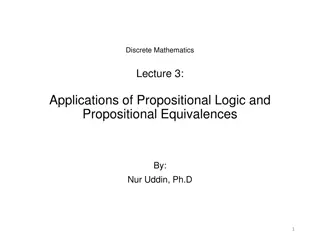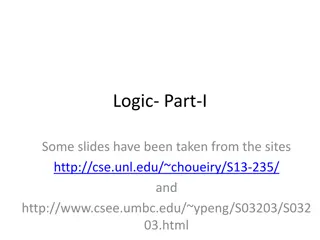Understanding Fundamentals of Logic: Propositions and Operations
A sentence is a collection of words, while a proposition is a meaningful declaration that can be either true or false. Learn about propositions, negation, conjunction, disjunction, and conditionals in logic.
Download Presentation

Please find below an Image/Link to download the presentation.
The content on the website is provided AS IS for your information and personal use only. It may not be sold, licensed, or shared on other websites without obtaining consent from the author. Download presentation by click this link. If you encounter any issues during the download, it is possible that the publisher has removed the file from their server.
E N D
Presentation Transcript
Fundamentals of Logic Sentence: A sentence is usually collection of words Proposition: A proposition is usually a declarative to which it is meaningful to assign one and only one of the truth values i.e. either true or false but now both. Proposition/ statement / premise Note: all propositions are sentences but all sentences need not be proposition. Examples Propositions Sachin is a player. 2+2=10 It is raining DMS is the subject of CSE True false false true 1 2 3 4
Examples Non propositions: 1. It is good 2. He is the tallest person in this class 4 2+x=10 5 What a beautiful morning! 6 Get up and do your exercises 7 The number x is an integer. 8 Are you busy?
Negation: If p is a proposition, then "p is not true" is a proposition, which we represent as ~p or 7p, and refer to it as "not p , "the negation of p", or "the denial of p". Not p is a proposition that is true when p is false and false when p is true Example: P: sachin is batsman. ~P: Q: sachin is not a tennis player ~Q: sachin is a tennis player sachin is not batsman
Conjunction: If p and q are propositions, then "p and q" is a proposition, which we represent in symbols as p ^ q and refer to it as the conjunction of p and q. The conjunction of p and q is true only when both p and q are true. Example: P: Q: sachin is a bowler P ^ Q: ~P ^ Q: P ^ ~Q: ~P ^ ~Q: (or) sachin is a batsman. sachin is batsman and bowler sachin is not a batsman and he is a bowler sachin is a batsman and he is not a bowler neither sachin is a batsman nor bowler sachin is not batsman and not a bowler
Disjunction: If p and q are propositions, then "p or q" is a proposition, which we represent in symbols as p V q and refer to it as the disjunction of p and q. Inclusive OR:either p is true or q is true or both Exclusive OR: either p is true or q is true but not both Example: P: sachin is a foot ball player. Q: sachin is a cricketer. P VQ: ~PVQ: PV~Q: ~PV~Q: sachin is foot ball player or cricketer. sachin is not a foot ball player or cricketer. sachin is foot ball player or he is not a cricketer sachin is not a foot ball player or not a cricketer
Conditional: The proposition "p implies q" or "if p then q" is represented as p q and is called an implication or a conditional. P is called the premise, hypothesis, or antecedent of the implication, and q is called the conclusion or consequent of the implication. p q is false only when the antecedent p is true and the consequent q is false. Example: P: 2 sides of a triangle are equal Q: triangle is isosceles p q: if 2 sides of a triangle are equal then it is isosceles q p: if triangle is isosceles then 2 sides of a triangle are equal ~p q: if 2 sides of a are not equal then it is isosceles. p ~q: if 2 sides of a are equal then it is not isosceles.
Bi-Conditional: The proposition "p double implies q" or "p if and only if q" or p iff q is represented as p q and is called a bi-conditional. P is called the premise, hypothesis, or antecedent of the implication, and q is called the conclusion or consequent of the implication. p q is true when both the statements are false / true p q is false when any one of them is true Example: P: 2 sides of a triangle are equal Q: triangle is isosceles p q: 2 sides of a are equal iff it is isosceles. q p: Triangle is isosceles if and only if 2 sides of are equal ~p q: 2 sides of triangle are not equal if and only if it is isosceles
If Conditional statement is its Inverse or Opposite is its Converse is its Contra positive is P Q then ~P ~Q Q P ~Q ~P Law of conditional / implication: Law of contra positive : P Q = ~PVQ P Q = ~Q ~P
Problems: Construct the truth tables for the following 1. [(pVq)^(~r)] q 2. (pVq)^( (~p)v(~r) ) 3. {(p^q)V(~p^r)} v (q^r) 4. [ (pVq) ^ (~r) ] (q r) 1. ~(PVQ) V [ (~P) ^ Q ] V P 2. [ (P Q) ^ (R S) ^ (PVR) ] (QVS) 3. [ (P R) ^ (Q R)] [(PVQ) R] Prove the following are tautologies
3. Consider the following propositions P: David is playing pool Q: David is inside R: David is doing his homework S: David is listening to music Translate following sentences into symbolic notations i. Either David is playing pool or he is inside ii. Neither is David playing pool, nor is he doing his homework iii. David is playing pool and not doing his homework iv. David is inside doing his homework, not playing pool v. David is inside doing his homework while listening to music, and he is not playing pool vi. David is not listening to music, nor is he playing pool, neither is he doing his homework.
4. i. ii. iii. ~( (~P) ^R) iv. [(~P)VQ] ^ [~R V S] v. [(~P) ^ Q] V [(~R) ^S] Translate the following into acceptable English (~P) ^ (~Q) P V(Q^R) 5. i. ii. iii. If triangle is isosceles , then base angles are equal iv. If K mart does not refund money, I will not shop there anymore. v. If lines AB & CD are parallel, then the alternate interior angles are equal. Restate the following implications into its equivalent ~pvq If he fails to follow orders, he will lose his commission. If the work is not finished on time then I am in trouble.
6. Find the truth values for the following i. P= T, Q= F and R=F then find [ (P^~Q) R] [P (QVR)] ii. P=T, Q=T and (P^Q) (RVS)= F then find R=?, S=?
Tautology: A tautology is a propositional function whose truth value is true for all possible values of the propositional variables. Example: PV~P Contradiction: A contradiction or absurdity is a propositional function whose truth value is false for all possible values of the propositional variables. Example: P ^ ~P Contingency: A propositional function that is neither tautology nor contradiction is called contingency Example: PVQ, P Q























